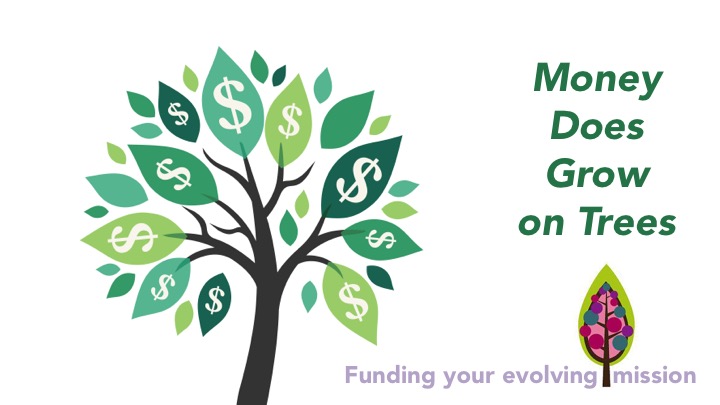 New opportunities to make long term impact on health and food security require a fresh approach to fundraising.
New opportunities to make long term impact on health and food security require a fresh approach to fundraising.
You’ve had enough of me mouthing off about my views – even if I am moving perilously close to the mainstream with the passing years. This time From Hunger to Health is drawing on two experts in the field to look at how we can take a new look at that money tree.
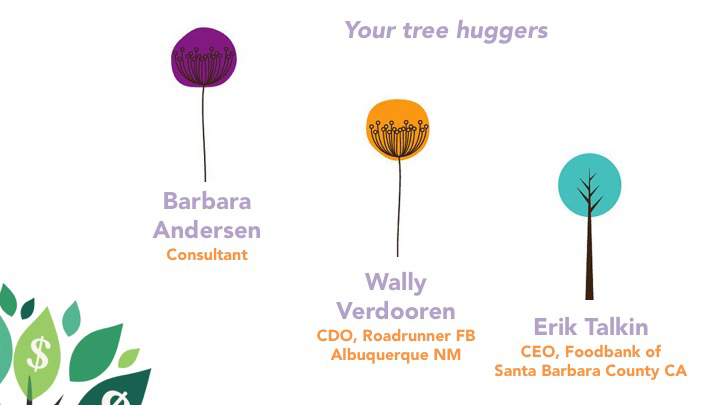
Wally Verdooren was until last year working as head of foundational relationships at Feeding America. Keen to see action in the field, Wally has joined Roadrunner Foodbank in Albuquerque New Mexico as their Head of Development. He is the perfect person to have a clear picture of the national situation and how the focus of foundations is changing.
We also have the opportunity to peer behind the curtain and speak to a former grantor. Until last year, Barbara Andersen, was head of strategic partnerships for the Orfalea Foundation, an influential local foundation that focused on food literacy. Barbara is now the Principal at All Points North Consulting ( bandersen@allpointsnorthconsulting.com) and she will be considering how you can develop your relationship with funders.
In the second part of this lavish two episode ‘mini-series’ of a blog post, I will look at what hard-won lessons have been learned by one food bank (my own) in order to give you practical tips on shaking the money tree.
THE CHANGING FUNDING SCENE
At the recent Closing the Hunger Gap conference in Portland, Oregon, Wally Verdooren took part in a workshop with me on this issue. He looked at the national perspective, considering how we can broaden and expand philanthropic support for ending hunger.

Wally believes that expanding and deepening your donor base does not require a shift in mission, but a broader expression of an organization’s identity/profile and a fluid and responsive advancement of your mission.
And it’s not just how your organization presents itself to the outside world. You need to eliminate an understanding, assignment, and evaluation of fundraising staff members as principally donation solicitors.
That’s a change of mindset for many of us. We want to keep poring the pressure on the fundraisers to live or die by last quarter’s figures. Wally argues that successful fundraising has become far more demanding and complex than simply preparing for and conducting requests for philanthropic contributions.
We need to advance and support an understanding and assignment of fundraising staff members as being:
- Relationship/partnership builders (internal & external)
- Project managers
- Program development partners
- Conveners
- Deal-makers
- Translators
Wally sees the need for this as having been heightened and accelerated by the 2008 Recession. It has also been spurred by both the admitted and unacknowledged failings of past financial support received from foundations. Now the desire is to emphasize OUTCOMES rather than OUTPUTS. More than ever, foundations are seeking new systemic, sustainable, and scalable strategies and solutions to persistent problems.
You know, like food insecurity.
Wally provided a thought-provoking ‘Golden Rule’ for Expanding Philanthropic Support:
“Whatever you’re buying, we’re selling.”
While that might initially sound like desperation or the first symptoms of mission drift, what Wally is really suggesting is that you focus FIRST on the donor’s/prospect’s motivations and goals for giving and not giving towards your organization’s needs, interests, and programs.
You should also go long and go deep in your prospective funder search by assessing motivations and goals for giving generally and specifically and then aligning them with what your organization actually does. This requires not only knowing your organization well, but not letting others define it.
What then are the fundable activities that are interesting foundations these days?
Key Trends/Priorities in Philanthropic Goals and Motivations:
- Promoting Health
- Advancing Community Economic Development
- Providing Direct Services to Stabilize Vulnerable Populations
- Engaging in Collective Impact
- Building and Strengthening Networks
- Conducting Data Tracking and Evidence Building
- Advocating for Public Policy Reform
- Ensuring Environmental Protection and Sustainability
Our job is to build cases for how these Trends/Priorities align with both current and planned anti-Hunger Work.
Wally put together a matrix that took some of the newer ‘evolved mission’ food banking activities and put them into buckets that foundations are going to be receptive to funding.

THE FUNDER PERSPECTIVE
That’s what we think funders are thinking…but what is really going on in their minds? At the same conference, Barbara Andersen, previously of the Orfalea Foundation http://www.orfaleafoundation.org and now the Principal at All Points North Consulting (bandersen@allpointsnorthconsulting.com) allowed us to peer inside her cranium and consider how to develop your relationship with funders
![Andersen[1]](https://fromhungertohealth.wordpress.com/wp-content/uploads/2016/02/andersen1.jpg?w=394&h=366)
The day to day reality of the funder can be overwhelm from the sheer number of inquiries and applications for resources. The dilemma is that most programs deserve support. One way that you can break from the hungry pack is to demonstrate:
- Your initiative is Strength-based vs. deficit-based. The former are positive, community-driven efforts that go behind the behavior to look at the drivers of that behavior. Deficit based efforts just respond to the behavior. Research has shown that strength-based interventions are sustainable, whereas deficit based activities are ineffective and may make the situation worse. This is all fruit for another post on Hunger into Health, as to how it applies to our specific work around the ‘deficit’ of hunger, but for now, those interested can also check out this short monograph: strengthsvsdeficitrb.
- Open and honest communication is vital. We all want to wear the happy face for foundations, but if there is a ‘situation’ then they will appreciate being kept in the loop, even having their advice sought. You can also offer your perspective as a peer, on the broader nonprofit environment in your area.
One of Barbara’s most helpful pieces of advice is that failure is an option. If you go back to a foundation and say, ‘we tried this and it didn’t work, but as a result of what we learned, we think this will be a better approach,’ then that is something that they can get behind.
Barbara also did us a service by teaching us the meaning of a few helpful phrases in the language of funders;

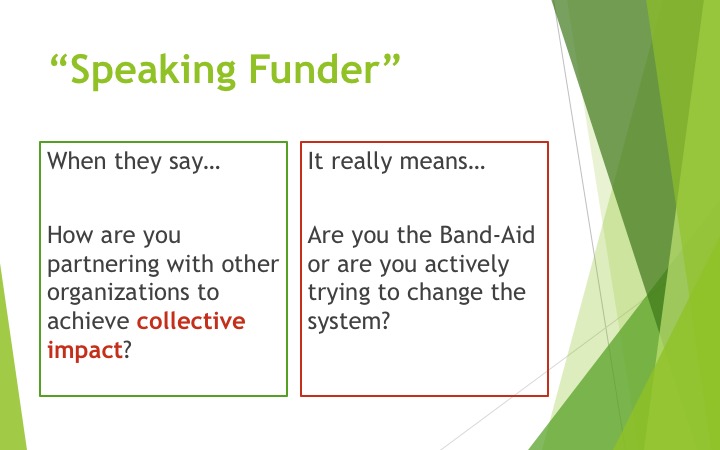
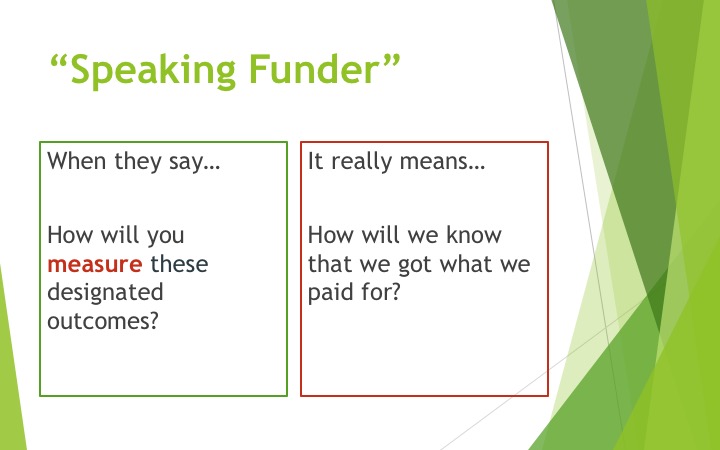
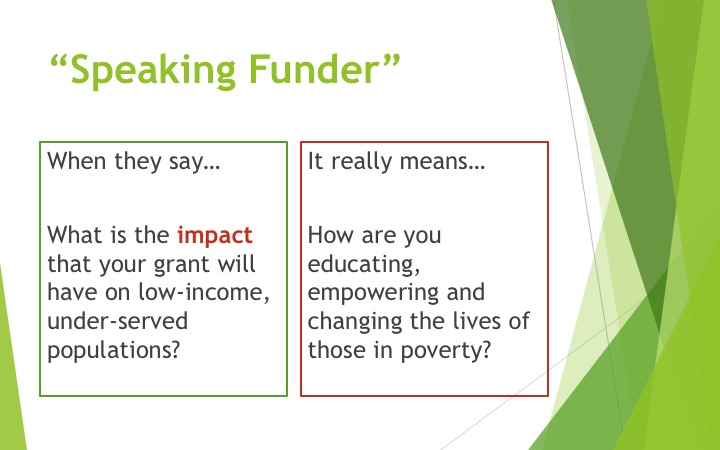
FUNDERS ARE PEOPLE TOO
It’s all about the relationship, so if your organization has evolved, you need to re-introduce yourself:
- “I would love to share with you our new vision for ending hunger…”
- “Your support has been so valuable to us. It would be very helpful to hear your thoughts on how our organization should position itself with other funders…”
- Relationship-Building
- “I would love to hear more about your new initiative in school food reform…”
- “Congratulations on your new position! Can we grab coffee? It would be great to learn from your past experiences in nonprofit management…”
WHEN IT IS A DEAD END
Sometimes it is important to understand when you need to move your efforts elsewhere, say if you have a foundation that is repeatedly shifting its focus or if you have to do too much work to apply for the grant compared to the support you would be receiving.

And ultimately, if you organization is compromising its values, mission and/or program objectives to chase after some random dollars, then you need to be able to let go of those crumpled bills and watch them blow down the road.
STAY TUNED FOR THE NEXT POST, DEAR READER
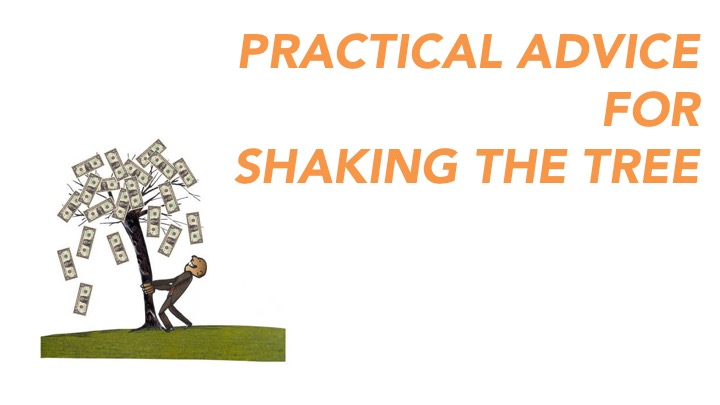
Now that we’ve looked at the bigger picture and the new opportunities to gain support, it will be time to consider what strategies we as organizations can enact to shake the money tree.
Available March 01
Hi Eric, thanks for another great post. I really wanted to read the matrix Wally put together but could not enlarge it enough for my old eyes. Is there another way to get at it?
Cheers,
Tomi
Tomi Melson
Director of Development and Community Relations
Second Harvest Food Bank of Northwest NC
3655 Reed Street, Winston-Salem, NC 27107
(336) 784-5770
Learn more at http://www.hungernwnc.org.
Stay informed on news and ways to get involved.
[cid:image001.gif@01D16021.38B72910]
Hi Tomi,
What I have is pretty low res picture, not the original file. I will email what I have, but the best way is just to maybe zoom it on your computer and take a screen grab. It will be a bit soft but readable at least.